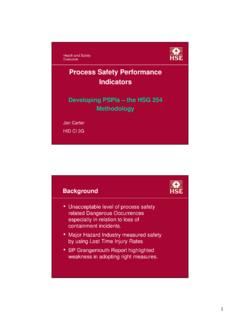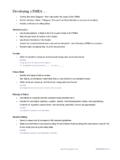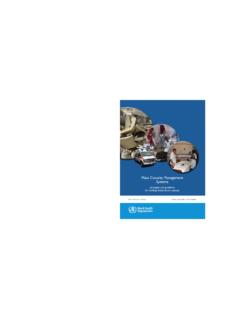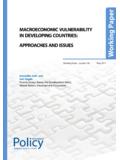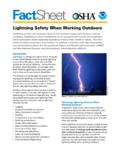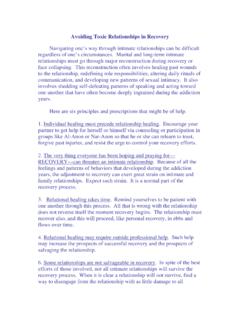Transcription of Early Warning Systems in the context of Disaster …
1 Early Warning Systems in the context of Disaster RiskManagementCountries have long been concernedabout the huge impacts that natur-al disasters have on society in de-veloped and especially in developingcountries. Unfortunately, societies havenot adapted their frameworks of devel-opment to the natural environment sur-rounding them and the losses and costsassociated with disasters of natural ori-gin. On the contrary societal catastro-phes are growing by the decade; globalannual Disaster costs of fifty billion USdollars are common. Between 1960 and1990 the economic losses of disastersincreased five times due to rising vulner-ability (MunichRe,NatCatSERVICE; GeoRisks Research,2005).
2 Our vulnerability tonatural hazards is growing, because pop-ulation increases and more people areliving in risky a million people have been killedover the last decade by disasters causedby storms, droughts, floods. While somematerial losses seem to be unavoidable,especially in the case of very large andinfrequent events, in some cases the lossof human lives could have been avoided ifthe proper precautions and measures hadbeen in place. This would have been thecase for the December 26, 2004 IndianOcean tsunami, which provoked fatalitiessurpassing a quarter of a million earlywarning systemsempower communitiesto prepare for andconfront the power ofnatural , the efficiencyof such Systems is to bemeasured in terms oflives saved andreduction in losses,which is directly relatedto the execution of ananticipated response bythe people andinstitutions once awarning is issued.
3 Thispaper addressestraditional views onearly Warning Systems ,and what it takes totransform them intoefficient, Sri Lanka, over 34,000 people lost theirlives due to the lack of a tsunami earlywarning system . While there would havebeen sufficient time to warn some of thecoastal population, the lack of awarenessregarding tsunamis, the lack of an earlywarning system , and the lack of trainingto respond to a Warning inhibited theauthorities and the local population fromexecuting the proper measures whichwould have significantly reduced the lossof traditional framework of Early warn-ing Systems is composed of three phases:monitoring of precursors, forecasting of aprobable event, and the notification of awarning or an alert should an event ofcatastrophic proportions take place.
4 Animproved four-step framework being pro-moted by national emergency agenciesand risk management institutions in-cludes the additional fourth phase: theonset of emergency response activitiesonce the Warning has been issued. Thepurpose of this fourth element is to rec-ognize the fact that there needs to be aresponse to the Warning , where the initialresponsibility relies on emergency res-ponse agencies (see figure).Effective Early Warning Systems requirestrong technical foundations and goodknowledge of the risks . But they must beJuan Carlos Villagran de Le n andJanos BogardiUnited Nations University Institute forEnvironment and Human Security (UNU-EHS)G rresstra e 1553113 BonnStefanie Dannenmann and Reid Basher Platform for the Promotion of EarlyWarning (UN/ISDR)G rresstra e 3053113 Bonn23entwicklung & l ndlicher raum 2/2006 Three phases of Early Warning systemsMeasurement ofprecursorsWarningWarningOnset of Antipated ResponseMeasurement ofprecursorsNoNoYesForecastindicatescata strophicevent?
5 Forecastindicatescatastrophicevent?YesSc hwerpunktCentralisation and decentralisation of EWSWhen analyzing who executes the two initial phases of the Early Warning Systems ,namely, monitoring and forecasting, one can see two trends, centralised systemswhere a national-type agency carries out these functions, and decentralised systemswhere these tasks are carried out by other agencies, municipal workers and volun-teers at the more local level. For example, in Central America, the national meteoro-logical agencies operate Early Warning Systems for hurricanes and for floods, includ-ing the emission of the Warning to the media. Such Systems are set up and operatedby these institutions.
6 In contrast, national Disaster reductionagencies, international organisations, and non-governmentalorganisations have been implementing decentralised Systems insmall basins, where communities carry out all phases, includingthe response. In such Systems , city halls are coordinating most ofthe activities, and are connected to the national emergencyagency via a radio network that is used to communicate all infor-mation within the decentralised Systems operate using much simpler equip-ment and are thus less precise, such Systems rely on a network ofpeople-operated radios to transmit information regarding pre-cursors to events or warnings .
7 The trade off gained from losingprecision to monitor and forecast events is gained by being ableto transmit other very useful information, generally related tosocial issues, such as medical needs, information regarding rela-tives or processes, or the solution of such problems as the fixingof power lines when they fail, or acquiring heavy machinery to re-open a road which might be blocked by a landslide. So far, com-munity-operated Systems have been mostly applied in the caseof floods, especially in small flood & l ndlicher raum 2/2006strongly people centred with clearmessages, dissemination Systems thatreach those at risk, and practiced andknowledgeable responses by risk man-agers and the public.
8 Public awarenessand education are critical; in addition,many sectors must be involved. Effectiveearly Warning Systems must be embed-ded in an understandable manner and rel-evant to the communities which four elements of people-centred Early Warning Systems A complete and effective, people-centredearly Warning system EWS comprisesfour inter-related elements, spanningknowledge of hazards and vulnerabilitiesthrough to preparedness and capacity torespond. A weakness or failure in any oneof these elements could result in failure ofthe whole system . Best practice EWS alsohave strong inter-linkages between all ele-ments in the chain.
9 While good governanceand appropriate institutional arrange-ments are not specifically represented onthe four element diagram , they are criti-cal to the development of effective earlywarning Systems . Good governance isencouraged by robust legal and regulatoryframeworks and supported by long termpolitical commitment and integrated insti-tutional arrangements. Major players con-cerned with the different elements shouldmeet regularly to ensure that they under-stand all of the other components andwhat other parties need from arise from both thehazards and the vulnerabilities that arepresent. What are the patterns and trendsin these factors?
10 Risk assessment andmapping will help to set priorities amongearly Warning system needs and to guidepreparations for response and disasterprevention activities. Risk assessmentcould be based on historic experience andhuman, social, economic and environmen-tal sound scientific basisfor predicting potentially catastrophicevents is required. Constant monitoring ofpossible Disaster precursors is necessaryto generate accurate warnings on that address many hazardsand involve various monitoring agenciesare most and warnings must reachthose at risk. For people to understand thewarnings they must contain clear, usefulinformation that enables proper respons-es.




